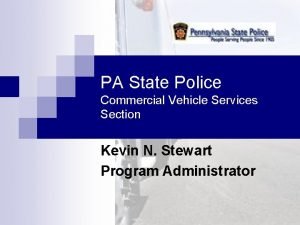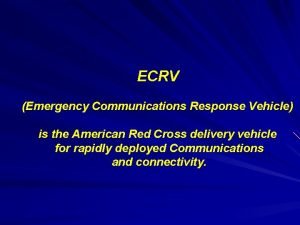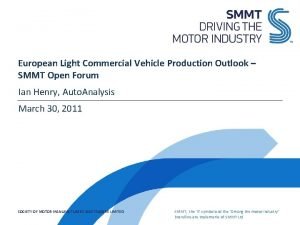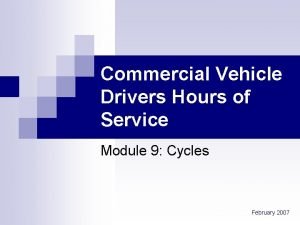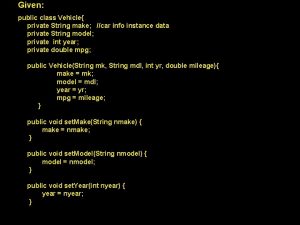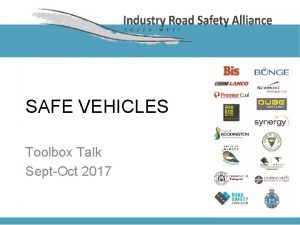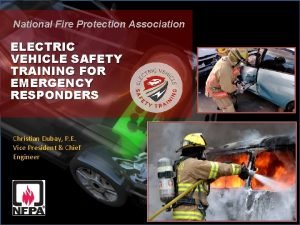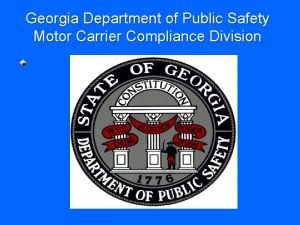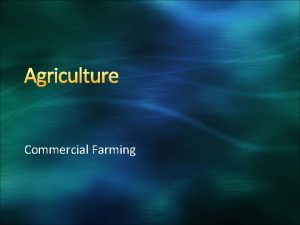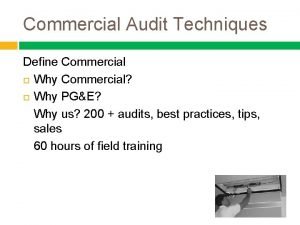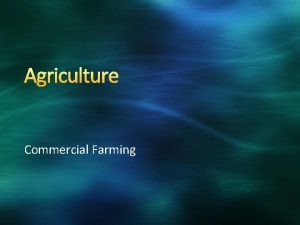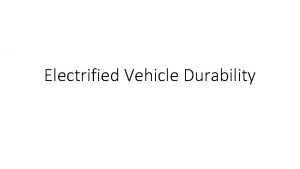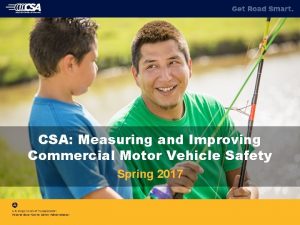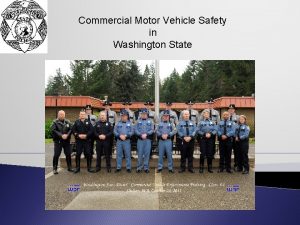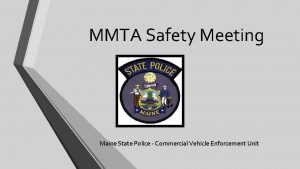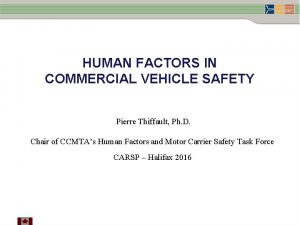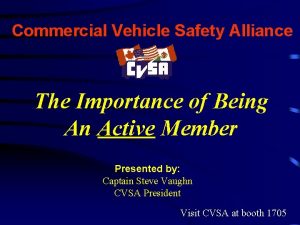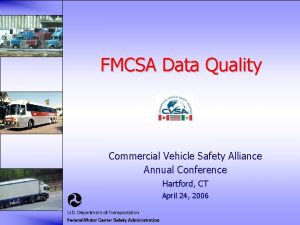VEHICLE SAFETY COMMUNICATIONS COMMERCIAL VEHICLE V 2 V
















- Slides: 16

VEHICLE SAFETY COMMUNICATIONS COMMERCIAL VEHICLE V 2 V RESEARCH PROGRAM 1/19/2010 Alrik L. Svenson Research Engineer NHTSA, Office of Applied Vehicle Safety Research Place Talking Freight

Outline • • • Vehicle Safety Communications Applications and Crash Types Crash Problem Overview Vehicle-to-Vehicle Communications (V 2 V) Research Plan Commercial Vehicle V 2 V Research Next Steps 2

Vehicle Safety Communications Connected vehicle environment 3

Vehicle Safety Communications Greater situational awareness • Your vehicle can “see” nearby vehicles and knows roadway conditions you can’t see Reduce or eliminate crashes thru: • Driver Advisories • Driver Warnings • Vehicle Control Vehicle safety communications have the potential to address 82% of crash scenarios for unimpaired drivers 4 Work Zone Notification Intersection Collision Avoidance

Safety Applications and Crash Types V 2 V & V 2 I Communications Other Lane Departure Warning Lane Keeping 23 % Curve Speed Warning Off Roadway 25 % Crossing Paths Lane Change 9 28 % % Rear-End Stop Sign & Signal Violation Warnings Blind Spot Detection Side Radar Forward Crash Warning Adaptive Cruise Control Brake Assist Automatic Braking 2005 GES - Includes all vehicle types 5

Crash Problem Overview • Vehicle safety communications have the potential to address a significant portion of the crash problem. • Volpe Center conducted analysis using 20052008 General Estimates System (GES) Data • Approximately 82% of crashes for all vehicles types could be addressed by vehicle safety communications 6

Distribution of Heavy Vehicle Crashes Analysis excludes crashes with an impaired driver 2005 -08 GES 7

Addressable Heavy Vehicle Crashes 2005 -08 GES 8

Top Addressable CV Crash Scenarios Pre-crash Scenario All Crashes V 2 V & V 2 I Changing lanes/Drifting same lane 69, 000 Rear-end 64, 000 Crossing paths 32, 000 Control loss 21, 000 Backing into vehicle 19, 000 Opposite Direction 14, 000 Running red light / stop sign 11, 000 Turns at traffic signals 8, 000 Turns at non signal 5, 000 Road edge departure 39, 000 3, 000 Parking 3, 000 Object contacted 36, 000 2005 -08 GES 9 AV 15, 000 16, 000

V 2 V Safety Research Plan Goals • Purpose • Accelerate the implementation of next generation of safety improvements through the widespread deployment of V 2 V - equipped vehicles of all types (truck, transit, auto & fleets) • Objectives • NHTSA regulatory decisions • 2013 Light Vehicles • 2014 Heavy Vehicles • Accelerate in-vehicle technology to ensure value to the first V 2 V vehicles 10

Vehicle to Vehicle Safety Application Research Plan CY 2009 CY 2010 CY 2011 CY 2012 CY 2013 TRACK 0 Complete CAMP-V SC-A Update Crash Scenarios System Engineering Current Activities TRACK 1 Define Initial Performance Requirements Crash Scenario Frame Work TRACK 2 Select Applications Data Authentication Complete Message and Communication Standards Development Tests Interoperability Final Standards & Protocols Security & Privacy (Certificate Authority) Define Performance Measures TRACK 3 Field Trails Benefits Assessment Performance Requirements Develop Objective Tests Adapt ACAT Methodology Conduct Objective Tests Safety Benefits Estimate LV Regulation Decision TRACK 4 Develop & Build Prototype Safety Application Vehicles Update Crash Scenarios Define Initial Performance Reqs and Measures Track 6 Governance (V 2 V) Policy Issues Business Models Security & Privacy Policy (V 2 V) Define Initial Performance Reqs and Measures Driver Issues 5. 9 Enforcement Retrofit & Aftermarket Req’ts TRACK 5 Driver Acceptance Driver Workload Issues DVI Effectiveness – Multiple Warnings Update Crash Scenarios Application Development Develop and Conduct Objective Tests Driver Workload Issues and Acceptance Field Tests (2014) Track 7 CVO Regulation Decision Commercial Vehicle FTA Implementation Decision (TBD) Track 8 Transit Vehicle

Commercial Vehicle V 2 V Research Plan Objective - Resolve the technical and policy issues necessary for deployment of Vehicle-to-Vehicle (V 2 V) systems on commercial vehicles. Key Tasks ● Identify priority CV crash scenarios. ● Select priority safety applications and determine performance requirements. ● Identify CV specific interoperability issues. ● Identify CV specific human factors / DVI issues. ● Build prototype vehicles and develop objective test procedures ● Vehicle testing for performance and DVI driver acceptance. ● Estimate safety benefits for CV applications. ● Identify CV policy issues and coordinate with overall program ● Support NHTSA regulatory decisions 12

Commercial Vehicle V 2 V Safety Application Research Plan CY 2009 1 Q TRACK 7 a Crash Scenario Framework 2 Q 3 Q CY 2010 4 Q 1 Q 2 Q 3 Q CY 2011 4 Q 1 Q 2 Q 3 Q CY 2012 4 Q 1 Q 2 Q 3 Q CY 2013 4 Q Benefits Assessment TRACK 7 c Interoperability TRACK 7 d Human Factors/ Driver Issues TRACK 7 e Planning & Outreach TRACK 7 f Policy 2 Q 3 Q 4 Q 1 Q 2 Q 3 Q 4 Q Identify Priority CV Crash Scenarios Select Critical Safety Applications Develop Performance Requirements TRACK 7 b 1 Q CY 2014 Estimate Safety Benefits Develop Objective Test Procedures Develop and Build Prototype Safety Application Vehicles Testing • Performance • Interoperability • Driver Acceptance Consumer Information for Fleets Develop Final Performance Specifications & Test Procedures Identify Priority CV Interoperability Issues Coordination with Interoperability program Identify Priority CV Human Factors Issues Develop CV DVI Guidelines Coordination with LV HF Research Webinar CV Research Plan CV Stakeholder Workshop Identify Primary Safety Performance Testing Safety Benefits/Implementation Applications/Interoperability CV Stakeholder Coordination Meeting Coordination with CV V 2 I Coordination with program Policy Issues – Security, Retrofit & Aftermarket, Enforcement, Governance NHTSA CV Regulatory Decision

2010 Commercial Vehicle V 2 V Research University of Michigan Transportation Research Institute Answer the Fundamental Questions for Deployment Virginia Tech Transportation Institute Battelle Center for Human Performance and Safety 14

Vehicle Safety Communications Next Steps • Build Prototype Trucks with Integrated V 2 V Systems • Perform Objective Testing at NHTSA Vehicle Research and Test Center (VRTC) • Conduct CV Driver Clinics • Publish RFP, award CV Retrofit Device Contracts • Participation in Safety Pilot Demonstration • Estimate Safety Benefits • NHTSA Regulatory Decision for CV in 2014 15

For More Information … Alrik L. Svenson NHTSA 1200 New Jersey Ave, S. E. W 46 -417 Washington, D. C. 20590 202 -366 -0436 Alrik. Svenson@dot. gov ITS Program: www. its. dot. gov/index. htm www. freightmobility. org 16
 Ipes certified carriers
Ipes certified carriers Commercial and non commercial food service
Commercial and non commercial food service Emergency communications response vehicle
Emergency communications response vehicle Commercial vehicle production
Commercial vehicle production Commercial vehicle
Commercial vehicle Travelling is very popular nowadays.
Travelling is very popular nowadays. Commercial aviation safety team
Commercial aviation safety team Java private string
Java private string Toolbox talk vehicle safety
Toolbox talk vehicle safety Canada motor vehicle safety regulations
Canada motor vehicle safety regulations Electric vehicle emergency field guide
Electric vehicle emergency field guide Motor carrier compliance division
Motor carrier compliance division Catzoc ecdis definition
Catzoc ecdis definition 00101-15 basic safety
00101-15 basic safety Qbs safety care
Qbs safety care Ind safety report
Ind safety report Personal safety vs process safety
Personal safety vs process safety
